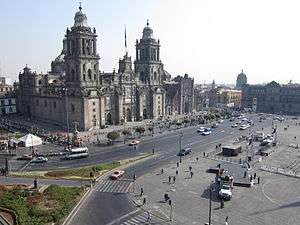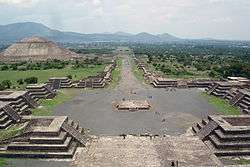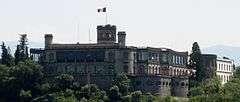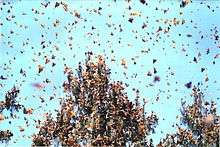Tourism in Mexico

Tourism in Mexico is a very huge industry. Mexico has traditionally been among the most visited countries in the world according to the World Tourism Organization, and it is the second-most visited country in the Americas, after the United States. The most notable attractions are the Meso-American ruins, cultural festivals, colonial cities, nature reserves and the beach resorts. The nation's temperate climate and unique culture – a fusion of the European and the Meso-American – make Mexico an attractive destination. The peak tourism seasons in the country are during December and the mid-Summer, with brief surges during the week before Easter and Spring break, when many of the beach resort sites become popular destinations for college students from the United States.
The majority of tourists come to Mexico from the United States and Canada. Other visitors come from Europe and Asia. A small number of tourists also come from other Latin American countries.[1] There is also a burgeoning domestic tourism trade as a growing affluent middle class begins to go on holiday within their own country. While Mexico's middle/lower class usually promotes national tourism, the middle/higher class usually prefers to travel overseas.
Tourism industry competitiveness
In the 2011 Travel and Tourism Competitiveness Index (TTCI) report, which is a measurement of the factors that make it attractive to developing business in the travel and tourism industry of individual countries, Mexico was ranked 43rd place in the world's ranking, which is fourth in the Americas.[2] In considering simply the subindex measuring human, cultural, and natural resources, Mexico ranks in the 13th place on a worldwide level, 10th for the natural resources criteria and 19th for the cultural criteria.[2] The TTCI report also notes Mexico's main weaknesses, which includes ground transport infrastructure (ranked 79th), insufficient health and hygiene (ranked 64th) and safety and security concerns (ranked 128th).[2]
Statistics
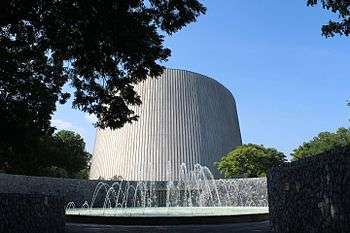
Most visitors arriving to Mexico by air for tourism in 2014 came from the following countries:[3]
| Rank | Country | Number |
|---|---|---|
| 1 | 7,164,375 | |
| 2 | 1,676,681 | |
| 3 | 458,932 | |
| 4 | 328,213 | |
| 5 | 310,123 | |
| 6 | 309,696 | |
| 7 | 246,404 | |
| 8 | 213,863 | |
| 9 | 207,031 | |
| 10 | 176,535 |
City destinations
Mexico City is the capital of Mexico and is popular with tourists as an ancient Meso-American city. It is the departure point for visits to the ancient city of Teotihuacan, famous for the Pyramid of the Sun and the Pyramid of the Moon. Other human-made tourist zones, such as the La Zona Rosa or Shopping District and El Zócalo (one of the largest public plazas in the world) are here. The city is also home to the Plaza de toros México – the world's largest bullring – and to the Mexican National Palace, built on the site of Montezuma's palace, and the huge Metropolitan Cathedral, the largest in the Western Hemisphere, built over the even greater Temple of Teocalli. Mexico City features the notable National Museum of Anthropology and History.

- Guadalajara, Jalisco, the second-largest city by population in the Republic, is home of some of Mexico's best known traditions, such as tequila, mariachi music and charros, or Mexican cowboys. Its similitude with western European countries mixed with modern architecture and infrastructure makes Guadalajara very attractive to tourists. Along with Mexico City and beach destinations (Cancun, Acapulco, etc.), Guadalajara is one of the most visited cities in Mexico. Cultural tourism is the main attraction, the city being home to a large number of museums, art galleries and theatres. The city is also the host of several internationally renowned events, such as the Guadalajara International Book Fair which is the most important exposition of its kind in the Spanish-speaking world, and the second largest book fair in the world.[4] The city is known as a pioneer in the underground arts scene as well as in the electronic music world, another main touristic attraction. Its diversity of European architectural styles is a focus of attraction for tourists, in particular the Metropolitan Cathedral, the Degollado Theatre and the Hospicio Cabañas which is a World Heritage Site and one of the oldest hospital complexes in Spanish America. Other tourism activities include shopping at its world class shopping malls, or plazas, taking a tour to the surrounding areas such as the Huentitan Canyon, Tonalá, Tlaquepaque, Chapala or visiting nearby towns, which are well-connected by modern highways, such as Tequila, Puerto Vallarta or Mazamitla, depending upon whether visitors seek urban, coastal or rural getaways.
- Monterrey, Nuevo Leon, was founded in the late 16th century. The downtown district is the oldest section in the city, surrounded by newer neighbourhoods. The Museo de Historia Mexicana (Museum of Mexican History), MARCO (Monterrey Museum of Contemporary Art), Metropolitan Museum of Monterrey and the Museum of the Palacio de Gobierno, or State House, are some of the better known museums in the city, as well as nationally. The Santa Lucia Riverwalk is a riverwalk similar to the one in San Antonio, Texas, having a length of 2.5 km (1.6 mi) and connecting the Fundidora Park with the Macroplaza, one of the largest plazas in the world.
- Morelia, Michoacán is the Capital of the State of Michoacán. Its Historic Downtown Area (Centro Histórico) encompasses approximately 150 city blocks in the city centre, roughly corresponding to the actual area of the city at the end of the 18th century. The Centro Historico contains over 1,000 historical sites, including (but not limited to) the cathedral and the aqueduct.
Other cities known for tourism (listed alphabetically) include:
- Chihuahua, Chihuahua
- Cabo San Lucas
- Dolores Hidalgo, Guanajuato
- Durango, Durango
- Guanajuato, Guanajuato
- Oaxaca, Oaxaca
- Puebla, Puebla
- León, Guanajuato
- San Cristóbal de las Casas, Chiapas
- San Miguel de Allende, Guanajuato
- Santiago de Querétaro, Querétaro
- Zacatecas, Zacatecas
Beaches
.jpg)
- Acapulco, Guerrero
- Cabo San Lucas, Baja California Sur
- Cancún, Quintana Roo
- Ensenada, Baja California
- Guaymas, Sonora
- Puerto Peñasco, Sonora (Also Called Rocky Point)
- Huatulco, Oaxaca
- Ixtapa, Guerrero
- Manzanillo, Colima
- Mazatlán, Sinaloa
- Mazunte, Oaxaca
- Playa del Carmen, Quintana Roo
- Puerto Escondido, Oaxaca
- Puerto Vallarta, Jalisco
- San José del Cabo, Baja California Sur
- Progreso, Yucatan
- Zipolite, Oaxaca

The coastlines of Mexico harbor many stretches of beaches that are frequented by sun bathers and other visitors. On the Yucatán peninsula, one of the most popular beach destinations is the resort town of Cancún, especially among university students during spring break. Just offshore is the beach island of Isla Mujeres, and to the east is the Isla Holbox. To the south of Cancun is the coastal strip called Riviera Maya which includes the beach town of Playa del Carmen and the ecological parks of Xcaret and Xel-Há. A day trip to the south of Cancún is the historic port of Tulum. In addition to its beaches, the town of Tulum is notable for its cliff-side Mayan ruins.

On the Pacific coast is the notable tourist destination of Acapulco. Once the destination for the rich and famous, the beaches have become crowded and the shores are now home to many multi-story hotels and vendors. Acapulco is home to renowned cliff divers: trained divers who leap from the side of a vertical cliff into the surf below.

Along the coast to the south of Acapulco are the surfing beaches of Puerto Escondido, the snorkeling, harbor beach of Puerto Ángel, and the naturist beaches of Zipolite. To the north of Acapulco is the resort town of Ixtapa and the neighboring fishing town of Zihuatanejo. Further to the north are the wild and rugged surfing beaches of the Michoacán coast.
Along the central and north Pacific coast, the biggest draws are beaches of Mazatlán city and the resort town of Puerto Vallarta. Less frequented is the sheltered cove of Bahía de Navidad, the beach towns of Bahía Kino, and the black sands of Cuyutlán. San Carlos, home of the Playa los Algodones (Cotton Beach), is a winter draw, especially for retirees.
At the southern tip of the Baja California peninsula is the resort town of Cabo San Lucas, a town noted for its beaches and marlin fishing.[5] Further north along the Gulf of California is the Bahía de La Concepción, another beach town known for its sports fishing. Closer to the United States border is the weekend draw of San Felipe, Baja California.
Mesoamerican ruins

- Malinalco
- Chichen-Itzá
- Tulum
- Monte Albán
- Calakmul and Edzná
- Palenque
- Xochicalco
- Teotihuacan
- El Tajín
- Uxmal
The central and southern parts of Mexico was host to several pre-Hispanic civilizations, the most prominent being the Aztec, Mayan, and the Olmec. There are numerous tourist destinations where these ruins can be viewed.
The Yucatán peninsula was home to the Mayan people, and many of the indigenous people still speak the language. The area also contains many sites where ruins of the Maya civilization can be visited. The richest of these are located in the eastern half of the peninsula and are collectively known as La Ruta Puuc (or La Ruta Maya). The largest of the Ruta Puuc sites is Uxmal, which was abandoned in the 12th century.

A one-hour drive to the northeast of Ruta Puuc are the surviving remains of the city of Mayapán. This settlement was controlled by Chichén Itzá to the east, now a large archaeological site with many interesting ruins. Other ruins on the peninsula include the aforementioned Tulum on the east coast, Cobá to the northwest of Tulum, Polé (now Xcaret) just south of Playa del Carmen and Calakmul in the nature reserve along the Guatemala border. However this list by no means exhausts the number of archaeological sites to be found in this area.
To the west, the state of Chiapas includes the temples and ruins of Palenque, the glyphs of the city of Yaxchilán, the painted walls of nearby Bonampak, and the remains of the fortress of Toniná. In the city of Villahermosa to the north is the Parque-Museo La Venta, with a collection of Olmec sculptures.
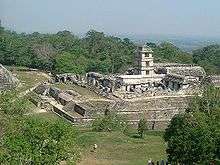
Along the gulf coast area in the state of Veracruz are more archaeological sites, with the Olmec ceremonial center of Tres Zapotes, the ruins of the large Totonac city of Zempoala, and the ruins of El Tajín with the Pyramid of the Niches. The city of Xalapa contains the Museo de Antropología, a notable museum featuring a collection of massive Olmec head sculptures.
In the state of Oaxaca along the Pacific coast are the ruins of Mitla, known as the "City of Death" and of Monte Albán, the remains of the once extensive Zapotec capital and religious center.
Moving to the north, the central region around Mexico City contains several archaeological sites. To the southwest are the massive ruins of Teotihuacán, including the Pyramid of the Sun and the Temple of Quetzalcoatl. To the southeast near the city of Cholula is the Great Pyramid, visible from the city center. Just to the north of Cholula are the well-preserved ruins of the city of Cacaxtla. Last but not least is the Toltec capital of Tula, to the north of Mexico City. In the capital itself is the largest museum in Mexico, the Museo Nacional de Antropología.
Finally, less visited than the major sites are the mysterious ruins of La Quemada, sometimes referred to as Chicomostoc, located south of Zacatecas, Zacatecas in the northern half of Mexico.
Spanish colonial history

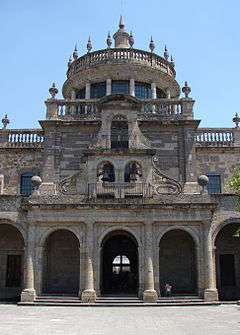
- Aguascalientes, Aguascalientes. Famous for its world-renowned festival San Marcos Fair during which it attracts 7 million tourists. This colonial City has gained prestige and status as a national destination for its colonial beauty, and absolute cleanliness. There are many amazing squares and gardens, surrounded by numerous buildings, from baroque churches to porfirian mansions.
- Campeche, Campeche. The only walled city in Mexico, is a World Heritage Site.
- Cuernavaca, Morelos. Historic marvelous architecture, many times hidden behind tall walls, fortresses and monasteries, some UNESCO sites
- Dolores Hidalgo, Guanajuato. The most important historical city of the country where the Mexican Independence War from Spain began.
- Durango, Durango. The most important northern colonial capital city in Mexico. Dubbed the Pearl of the Guadiana Valley, has many colonial Mansions, one of these is the Count of Suchil Palace.
- Guanajuato, Guanajuato. It's a wonderful colonial treasure. This was the second most important city of the Viceroyalty of the New Spain. The whole town is a World Heritage Site.
- Mérida, Yucatán. Dubbed the white city, with Mayan tradition has many colonial Mansions of impressive beauty.
- Mexico City. The City of Palaces as Alexander von Humboldt called it. It has been the capital of the country for almost 700 years. Since the foundation of the Aztec Empire until nowadays.
- Morelia, Michoacán. Excellent colonial architecture can be admired in this city.
- Oaxaca, Oaxaca. Colonial Architecture and Indigenous tradition are mixed here.
- Puebla, Puebla. The city of colorful tiles and Grand architecture, its historic center is a World Heritage Site
- Querétaro. The state capital has a beautiful baroque downtown, declared a World Heritage Site. Other popular destinations include the third tallest monolith in the world (Peña de Bernal), a city famous for its thermal springs in the middle of a wine and cheese making area (Tequisquiapan), and astonishing natural and cultural beauties in the biosphere reserve of Sierra Gorda.
- San Luis Potosí, San Luis Potosí. Rich in ancient times from its mines, this colonial city was the capital of Mexico twice.
- San Miguel de Allende, Guanajuato. One of Mexico's oldest towns. Many historic churches and the open-air Plaza Allende. An exceptional beauty Gothic Cathedral is located here.
- Sombrerete, Zacatecas. Colonial town, it is famous for the historic churches and the colonial architecture.
- Taxco, Guerrero. Silver jewelry. A very famous baroque church is located here, its interior is the most admired since the baroque ornamentations are all covered in gold.
- Tlaxcala, Tlaxcala. Four centuries without change are present in this city, famous for its Arabic mudejar open air chapel, next to the cathedral.
- Veracruz, Veracruz. The first City Hall in the Americas was settled here.
- Zacatecas, Zacatecas. The city downtown is a UNESCO World Heritage Site. It is famous for the astonishing pink facade of its cathedral, it is baroque in style, and exuberant in its ornamentation. The city is a delight for the national tourism.
Ecotourism
- El Cielo Biosphere
- Barranca del Cobre
- Cascada de Texolo
- Durango
- El Nevado
- El Rosario – in the last two months of the year, a mass migration of monarch butterflies reaches the El Rosario sanctuary near Zitácuaro, Michoacán.
- Isla Mujeres
- Pinacate Peaks
- La Bufadora
- Reserva de la Biosfera El Cielo
- Sian Ka'an
- Gulf of California
- Parque Nacional Sierra de Organos (Sombrerete, Zacatecas)
- Parque Nacional Sierra San Pedro Mártir
- Real de Catorce
- Tzararecuita
- Monarch Butterfly Biosphere Reserve
General tourism

- Monterrey, Nuevo León
- Nuevo Laredo, Tamaulipas
- León, Guanajuato
- Guadalajara, Jalisco – and nearby Lake Chapala
- Papantla, Veracruz – vanilla
- Piedras Negras, Coahuila
- San Cristóbal de las Casas, Chiapas
- San Luis Potosí, San Luis Potosí
- Saltillo, Coahuila
- Tequila, Jalisco
- Tijuana, Baja California
- Torreón, Coahuila
- Puerto Vallarta festival
- San Sebastián del Oeste, Jalisco
- Zipolite, and Mazunte, Oaxaca
-

Trajinera boats at the floating gardens of Xochimilco in Mexico City
-
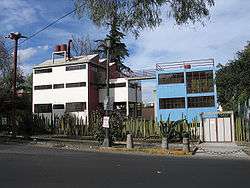
House of Diego Rivera and Frida Kahlo
See also
Further reading
- Berger, Dina. The Development of Mexico's Tourism Industry: Pyramids by Day, Martinis by Night (2006) excerpt and text search
- Berger, Dina, and Andrew Grant Wood, eds. Holiday in Mexico: Critical Reflections on Tourism and Tourist Encounters (Duke University Press; 393 pages; 2010) . Essays on the history of tourism and related realms in Mexico; topics include the marketing of carnival in Veracruz.
- Agencias de viaje en línea especializadas en el país que ofrecen meses sin intereses y seguridad en los pagos. GranTravel.[6]
References
- ↑ "SECTUR (2006). "Turismo de internación 2001–2005, Visitantes internacionales hacia México" (in Spanish). Secretaría de Turismo (SECTUR). Archived from the original on 2008-06-10. Retrieved 2008-07-26. pp. 5
- 1 2 3 Blanke, Jennifer; Chiesa, Thea (2011). "The Travel & Tourism Competitiveness Report 2011 - Beyond the Downturn" (PDF). World Economic Forum, Geneva, Switzerland. Retrieved February 23, 2013.
- ↑ Visitantes internacionales por vía aérea por principal nacionalidad
- ↑ http://www.fil.com.mx/ingles/i_info/i_info_int.asp
- ↑ http://icabo.com/what-to-do/cabo-fishing.aspx
- ↑ http://deviajeconarmani.blogspot.mx/2014_04_01_archive.html
- “UNWTO Annual Report.” World Tourism Organization. Accessed November 20, 2013.
- “Cultura Turistica.” Secretaria de Turismo. Accessed November 20, 2013.
- Hernandez, Alejandra. (August 2010) “Mexicana de Aviacion se Clausura.” El Universal. Accessed November 20, 2013.
- Gallagher, Margaret (2008), "Feminist issues and the global media system", in Sarikakis, Katharine; Leslie Regan, Shade, Feminist interventions in international communication: minding the gap, Lanham, Maryland: Rowman & Littlefield, pp. 17–32, ISBN 9780742553057.
External links
-
 Mexico travel guide from Wikivoyage
Mexico travel guide from Wikivoyage - Mexico Tourism Official Website
- U.S. Department of State, Mexico, Travel Warnings
